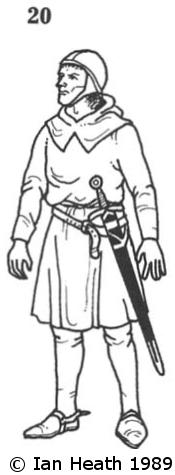|
|
MOUNTED SERVANT, 13th CENTURY
An extract from Armies of Feudal Europe 1066-1300
by Ian Heath
20. MOUNTED SERVANT, 13th CENTURY
During this period a knight's mounted retainers or servants who accompanied him on campaign were generally described by anyone of three different terms,
these being valet (Latin vallerus, often translates as 'yeoman'), esquire (Latin armiger or scutifer, French écuyer),
or simply 'boy' (Latin garcio, French puer), not all of which necessarily denoted the same type of servant though they all received the same pay
(1s. a day in 13th century England, compared to 2s. for a knight).
'Esquire' is the most commonly found, clearly denoting the origin of such servants as armour- or shield-bearers.
This has led to many modern authorities mistakenly concluding that they were noncombatants,
citing the 'Rule of the Temple' which describes the functions of a Knight Templar's 2 esquires as holding his lance and spare horse respectively,
both withdrawing to the rear before battle was joined.
Admittedly they might not be expected to play a particularly active role on the battlefield (they might only guard the baggage or the spare horses,
or take captive unhorsed enemy cavalrymen, as Frederick II's did at Cortenuova), but it is clear from contemporary sources that such servants were invariably armed -
even the 'boys' of an Angevin knight's retinue in Sicily in 1283 were armed with sword and knife and wore mail hoods, probably supplemented by quilted body-armour.
The figure depicted here, found lurking behind his master Goliath in two scenes in the
'Maciejowski Bible' of c.1250, is less well-equipped, having only a sword and arming-cap.
The latter is white, while his tunic is light brown, shoes are dark brown and hose are light green.
By the late-12th century a knight was normally accompanied on campaign by 2 esquires, or occasionally even 3, who were at that time still no more than low-born retainers.
However, as the 13th century progressed it seems to have gradually become accepted practice for noble
youths to get their military training by becoming esquires, with the result that they became better equipped and assumed a more active role in battle;
certainly esquires fought, and died, at battles such as Evesham (1265) and Stirling Bridge (1297).
After c.1250 the terms scurtiferi, valletti and servientes alike were used synonymously with 'men-at-arms' (homines ad arma or armati)
denote non-knightly mounted soldiers, and by the end of the 13th century they were clearly indistinguishable from knights in all but title.
[Based on the upper register of folio 27r and the
lower right panel of folio 27v of the Morgan Crusader Bible of Louis IX or Maciejowski Bible.]
|  |
Next: 21. TRUMPETER, 12th-13th CENTURIES
|